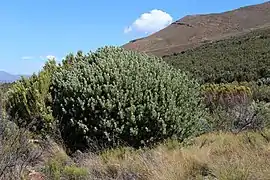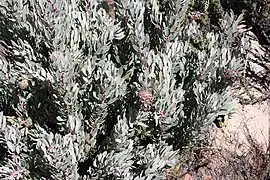Protea pendula
Protea pendula, also known as the nodding sugarbush[1][4] or arid sugarbush,[5] is a flowering plant of the genus Protea, in the family Proteaceae,[1][4][5] which is only found growing in the wild in the Cape Region of South Africa.[1][3] In the Afrikaans language it is known as knikkopsuikerbossie or ondersteboknopprotea.[1]
| Protea pendula | |
|---|---|
 | |
| Protea pendula in South Africa | |
| Scientific classification | |
| Kingdom: | Plantae |
| Clade: | Tracheophytes |
| Clade: | Angiosperms |
| Clade: | Eudicots |
| Order: | Proteales |
| Family: | Proteaceae |
| Genus: | Protea |
| Species: | P. pendula |
| Binomial name | |
| Protea pendula | |
| Synonyms[3] | |
| |
Taxonomy
Protea pendula was first described by Robert Brown in his 1810 treatise On the Proteaceae of Jussieu.[2][6][7]
The holotype is an exsiccata collection made by Francis Masson in the early 1770s in an unspecified location in South Africa. There is an isotype in the herbarium assembled by William Forsyth, which is now held at Kew. The species was collected again in 1831 by Karl Ludwig Philipp Zeyher (accompanied by Christian Friedrich Ecklon) in the Witzenberg Mountains to the east of the town of Tulbagh.[7]
Description
This plant grows as an erect shrub up to three metres tall.[5] The younger branches are softly hirsute, eventually becoming glabrous with age.[7] The leaves are glaucous,[4] distinctly veined beneath, 0.75–1.75 inches (1.9–4.4 cm) in length, and approximately 0.5cm in width. They are shaped narrowly-oblanceolate, ending in an acute apex with a mucronate tip. Young leaves are covered in a very minute, loose pubescence, but become glabrous as they get older.[7]
The flowers are bourne on a specialised inflorescence, a flower head or pseudanthium. The flower head is sessile, 1.5 inches (3.8 cm) in length, and around 1.5 inches (3.8 cm) in diameter.[7] The flower heads are dropping, opening downwards.[4][7] It is monoecious, with both sexes occurring in each flower.[5] The inflorescences are produced in the late autumn to winter, mostly in May to June, extending to August.[4][5] There are seven to eight series of involucral bracts.[7] The outer bracts are often coloured a dull, mealy red,[4] are shaped ovate to subacuminate (somewhat pointy), with an obtuse apex, and covered in silky-pubescent or tomentose hairs on their lower halves. Their margins are membranous and ciliate (fringed with hairs). The inner bracts longer than the actual flowers and are shaped obtuse, in-curved at their tops, slightly concave and covered in minute pubescent hairs on their outsides. The petals and sepals of the flowers are fused into a 19mm long perianth-sheath. This sheath is dilated, having three keels and three veins at its base, and reddish, pilose hairs on the outside of the very top of the sheath, where it has a 5mm long lip with the underside covered in a few, stiff, setose (bristly) hairs of a reddish colour. The lip is three-toothed, with each tooth almost equal in length, 0.7mm. All of the stamens are fertile. The anthers are linear and 2.6mm long. The apical glands are ovate and somewhat less than 0.3mm in length. The ovary is oblong and covered in long, reddish-brown hairs. The style is glabrous, compressed, curved to falcate in shape and some 21.2mm long. It is obliquely dilated above the ovary, then gradually tapering. The stigma is 3.2mm long, thread-like in shape, obtuse, and almost imperceptibly becomes the style.[7]
Similar species
It is similar to Protea effusa, as well as P. sulphurea, from which it differs by having narrower leaves with more distinct venation. It is also somewhat similar to P. witzenbergiana, differing in that species having long, foliaceous, leaf-like, outer involucral bracts.[7]:594[8]
Distribution
Protea pendula is endemic to the Western Cape province of South Africa.[1] It occurs in isolated, scattered populations from the Cedarberg Mountains,[5] such as on the Wolfberg,[4] to the Koue Bokkeveld Mountains,[5] such as on the Waboomsberg.[4]
Ecology
The adult plants are killed by wildfires, but the seeds can survive such an event. The flowers are pollinated by birds. The fruits are numerous, studding the base of the dried, old flower head, which itself remains attached to the plant after senescence. The seeds are retained in the fruits for a few years, until they are eventually dispersed by the wind.[5]
Gallery
 Protea pendula bush
Protea pendula bush Protea pendula
Protea pendula Protea pendula
Protea pendula Protea pendula
Protea pendula Protea pendula leaves
Protea pendula leaves Flower of Protea pendula
Flower of Protea pendula Flower of Protea pendula
Flower of Protea pendula Flower of Protea pendula
Flower of Protea pendula Flower of Protea pendula
Flower of Protea pendula Protea pendula flower
Protea pendula flower Protea pendula flower
Protea pendula flower Protea pendula seedhead
Protea pendula seedhead
Conservation
The rate of change in population is believed to be stable. The conservation status this species was first assessed as 'least concern' by the South African National Biodiversity Institute (SANBI) in 2009. In 2019 another group of authors re-assessed it for SANBI as 'least concern' again.[1]
See also
- List of Protea species – Wikipedia list article
References
- Rebelo, A.G.; Mtshali, H.; von Staden, L. (10 June 2019). "Nodding Sugarbush". Red List of South African Plants. version 2020.1. South African National Biodiversity Institute. Retrieved 13 August 2020.
- "Protea pendula". International Plant Names Index. The Royal Botanic Gardens, Kew, Harvard University Herbaria & Libraries and Australian National Botanic Gardens. Retrieved 13 August 2020.
- "Protea pendula R.Br". Plants of the World Online. Kew Science. 2017. Retrieved 12 August 2020.
- "Protea pendula (Nodding sugarbush)". Biodiversity Explorer. Iziko - Museums of South Africa. Retrieved 13 August 2020.
- "Penduline Sugarbushes - Proteas". Protea Atlas Project Website. 11 March 1998. Retrieved 27 April 2020.
- Brown, Robert (1810). "On the Proteaceae of Jussieu" (PDF). Transactions of the Linnean Society of London. 10 (1): 87. doi:10.1111/j.1096-3642.1810.tb00013.x. Retrieved 19 July 2020.
- Stapf, Otto; Phillips, Edwin Percy (January 1912). "CXVII. Proteaceæ". In Thiselton-Dyer, William Turner (ed.). Flora Capensis; being a systematic description of the plants of the Cape Colony, Caffraria & Port Natal. 5. 1. London: Lovell Reeve & Co. p. 590, 591. doi:10.5962/bhl.title.821.
- Phillips, Edwin Percy (1910). "Diagnoses Africanae: XXXVII". Bulletin of Miscellaneous Information, Royal Gardens, Kew (in Latin). 1910 (7): 233, 234. Retrieved 14 August 2020.